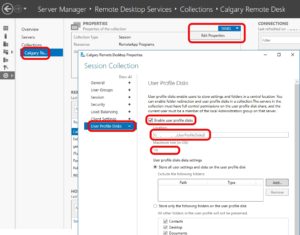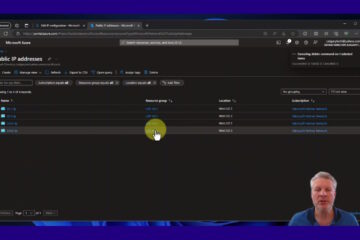A User Profile Disk is simply a VHDX that is created for each user that contains their C:\USERS\<user> profile and blocks remote users from interacting with the physical disk. This is good for security and also lets user profiles roam across different Session Hosts.
Setting up User Profile Disks is easy but the thing tech’s make a mistake on is using a local path. You MUST use a path that all of your RDS users can get to. We recommend that you make it a hidden network share so that others on your network can not see it.
To Setup & Enable RDS User Profile Disks:
- Create a shared network location for the disks
- We suggest that if you don’t already have a better location, that you use your RDS Gateway or Broker server and create a path like E:\UserProfileDisks and then a share like \\YourServerNameHere\UserProfileDisks$
- The ‘$’ makes it a hidden share so your staff can’t easily browse for it. The $ is NOT required, but we like it.
- We suggest that if you don’t already have a better location, that you use your RDS Gateway or Broker server and create a path like E:\UserProfileDisks and then a share like \\YourServerNameHere\UserProfileDisks$
 Launch SERVER MANAGER
Launch SERVER MANAGER- Expand REMOTE DESKTOP SERVICES > COLLECTIONS
- Click on your Collection
- Click TASKS > EDIT PROPERTIES (top right corner)
- Click USER PROFILE DISKS (bottom of the menu on the left)
- Click ENABLE USER PROFILE DISKS
- Set the location to what you created in step 1
- i.e. \\YourServerNameHere\UserProfileDisks$
- Set the maximum size of those disks.
- User Profile Disks are dynamically expanding disk
- The default is 20GB but we like 10GB because we want our remote users to mostly save things on the network and not on there Desktop or Documents
- Scroll down and set what you want to have stored on those VHD’s.
- The default is everything, and that is what we like, so we left it at STORE ALL USER SETTINGS AND DATA ON THE USER PROFILE DISK
That’s it boss. From this point on your RDS users will have new VHD’s created in \\YourServerNameHere\UserProfileDisks$ .
One thing to note is that if those users already had profiles, they will be ignored and fresh ones created the first time they sign in. Also of note is that the User Profile Disk VHD name will be the user GUID, not their username like it normally is in C:\USERS\<username> .
This article was created as reference material for our article on GPO’s To Lock Down RDS Session Hosts.
You might find this video useful, even though it is for Server 2012:



1 Comment
SOLVED: GPOs To Lock Down Your Remote Desktop Session Host Server - Up & Running Technologies, Calgary IT Services · April 5, 2018 at 3:42 pm
[…] profile and blocks remote users from interacting with the physical disk. If you want to use USER PROFILE DISKS click HERE for more information. If you don’t want to use USER PROFILE DISKS, you should consider […]